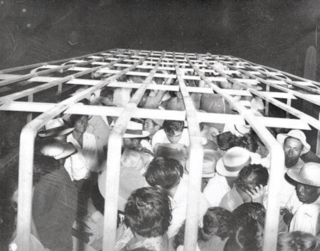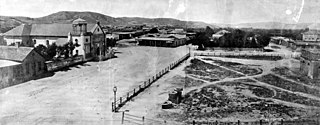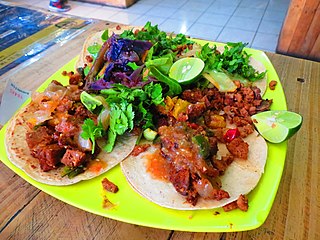Related Research Articles

A maquiladora, or maquila, is a word that refers to factories that are largely duty free and tariff-free. These factories take raw materials and assemble, manufacture, or process them and export the finished product. These factories and systems are present throughout Latin America, including Mexico, Paraguay, Nicaragua, and El Salvador. Maquiladoras date back to 1964, when the Mexican government introduced the Programa de Industrialización Fronteriza. Specific programs and laws have made Mexico's maquila industry grow rapidly.

Operation Wetback was an immigration law enforcement initiative created by Joseph Swing, the Director of the United States Immigration and Naturalization Service (INS). The program was implemented in June 1954 by U.S. Attorney General Herbert Brownell. The implementation of Operation Wetback was a result of Attorney General Herbert Brownell's touring of Southern California in August 1953. It was here that he made note of the "shocking and unsettling" issue that was illegal immigration. The short-lived operation used military-style tactics to remove Mexican immigrants—some of them American citizens—from the United States. Though millions of Mexicans had legally entered the country through joint immigration programs in the first half of the 20th century and some who were naturalized citizens who were once native, Operation Wetback was designed to send them to Mexico.

Beautiful Losers is the second and final novel by Canadian writer and musician Leonard Cohen. It was published in 1966, before he began his career as a singer-songwriter.

The Bracero Programs were the result of a series of laws and diplomatic agreements, initiated on August 4, 1942, when the United States signed the Mexican Farm Labor Agreement with Mexico. For these farmworkers, the agreement guaranteed decent living conditions and a minimum wage of 30 cents an hour, as well as protections from forced military service, and guaranteed that a part of wages was to be put into a private savings account in Mexico; it also allowed the importation of contract laborers from Guam as a temporary measure during the early phases of World War II.
Transnationalism is a research field and social phenomenon grown out of the heightened interconnectivity between people and the receding economic and social significance of boundaries among nation states.
Mixtec transnational migration is the phenomenon whereby Mixtec people have migrated between Mexico and the United States, for over three generations.

Foreign nationals (aliens) can violate US immigration laws by entering the United States unlawfully or lawfully entering but then remaining after the expiration of their visas, parole, TPS, etc. Illegal immigration has been a matter of intense debate in the United States since the 1980s.
A guest worker program allows foreign workers to temporarily reside and work in a host country until a next round of workers is readily available to switch. Guest workers typically perform low or semi-skilled agricultural, industrial, or domestic labor in countries with workforce shortages, and they return home once their contract has expired.

Emigration from Mexico is the movement of people from Mexico to other countries. The top destination by far is the United States, by a factor of over 150 to 1 compared to the second most popular destination, Canada.

Colloquially, a coyote is a person who smuggles immigrants across the Mexico–United States border. The word "coyote" is a loanword from Mexican Spanish that usually refers to a species of North American wild dog (Canis latrans).

Indian Mexicans are Mexican citizens who are descendants of migrants from India.
Transmigrant is a term, greatly developed by the work of Nina Glick Schiller, which is used to describe mobile subjects that create and sustain multiple social relations that link together their societies of origin and residence. These mobile subjects are now viewed as transnational migrants or transmigrants to distinguish them from migrants and immigrants.
Latinidad is a Spanish-language term that refers to the various attributes shared by Latin American people and their descendants without reducing those similarities to any single essential trait. It was first adopted within US Latino studies by the sociologist Felix Padilla in his 1985 study of Mexicans and Puerto Ricans in Chicago, and has since been used by a wide range of scholars as a way to speak of Latino communities and cultural practices outside a strictly Latin American context. As a social construct, latinidad references "a particular geopolitical experience but it also contains within it the complexities and contradictions of immigration, (post)(neo)colonialism, race, color, legal status, class, nation, language and the politics of location." As a theoretical concept latinidad is a useful way to discuss amalgamations of Latin American cultures and communities outside of any singular national frame. Latinidad also names the result of forging a shared cultural identity out of disparate elements in order to wield political and social power through pan-Latino solidarity. Rather than be defined as any singular phenomenon, understandings of Latinidad are contingent on place-specific social relations.

Mexican Americans have lived in Los Angeles since the original Pobladores, the 44 original settlers and 4 soldiers who founded the city in 1781. People of Mexican descent make up 31.9% of Los Angeles residents, and 32% of Los Angeles County residents.

The Chualar bus crash took place on September 17, 1963, when a freight train collided with a makeshift "bus"— a flatbed truck with two long benches and a canopy— carrying 58 migrant farmworkers on a railroad crossing outside Chualar in the Salinas Valley, California, United States, killing 32 people and injuring 25. Because the vehicle was actually a truck carrying people in the back, rather than a bus, the crash is ranked as the deadliest automobile accident in U.S. history, according to the National Safety Council.
Hometown associations (HTAs), also known as hometown societies, are social alliances that are formed among immigrants from the same city or region of origin. Their purpose is to maintain connections with and provide mutual aid to immigrants from a shared place of origin. They may also aim to produce a new sense of transnational community and identity rooted in the migrants' country of origin, extending to the country of settlement. People from a variety of places have formed these associations in several countries, serving a range of purposes.
The Mexican American middle class is a sub population of people of Mexican descent living in the United States who identify with a middle class status.

Mexican-American cuisine is the cuisine of Mexican Americans and their descendants, who have modified Mexican cuisine under the influence of American culture and immigration patterns of Mexicans to the United States.
Henry Pope Anderson was a farm labor union organizer, activist, author, and historian. He studied the Bracero program as a graduate student in Public Health at the University of California. He was Director of Research at Agricultural Workers Organizing Committee (AWOC), an early AFL/CIO-sponsored effort to unionize farm workers. Anderson organized and led Citizens for Farm Labor, a San Francisco Bay Area-based group that supported farm labor organization activities. He wrote the book “So Shall Ye Reap” documenting the history of farm labor unionization in California.
A Mexican American is a resident of the United States who is of Mexican descent. Mexican American-related topics include the following:
References
- ↑ Dent, David W. (2002). Encyclopedia of Modern Mexico . Scarecrow Press. pp. 23. ISBN 9780810842915.
- ↑ Koulish, Robert (2010). Immigration and American Democracy: Subverting the Rule of Law. Routledge. p. 63. ISBN 9781135843311.
- 1 2 3 Cohen, Deborah (2011). Braceros: Migrant Citizens and Transnational Subjects in the Postwar United States and Mexico . Chapel Hill, NC: University of North Carolina Press. pp. 91. ISBN 9780807833599.
- 1 2 3 4 Mitchell, Don (2012). They Saved the Crops: Labor, Landscape, and the Struggle Over Industrial Farming in Bracero-Era California. Athens, GA: The University of Georgia Press. p. 84.
- 1 2 3 4 5 Cohen, Deborah (2011). Braceros: Migrant Citizens and Transnational Subjects in the Postwar United States and Mexico . Chapel Hill, NC: University of North Carolina Press. pp. 92. ISBN 9780807833599.
- 1 2 Mitchell, Don (2012). They Saved the Crops: Labor, Landscape, and the Struggle Over Industrial Farming in Bracero-Era California. Athens, GA: The University of Georgia Press. p. 220.
- ↑ Nadel, Leonard. "Braceros wait in the shade of a building during processing at the Monterrey Processing Center, Mexico", "Bracero History Archive" Retrieved 11 April 2015.
- ↑ Nadel, Leonard. "An officer, armed with a rubber truncheon, monitors a line of braceros during processing at the Monterrey Processing Center, Mexico", "Bracero History Archive" Retrieved 11 April 2015.
- ↑ Nadel, Leonard. "Braceros wait in long lines grouped by state of origin at the Monterrey Processing Center, Mexico. Vendors, including women and children, sell refreshments in the sun", "Bracero History Archive" Retrieved 11 April 2015.
- 1 2 3 4 5 6 Cohen, Deborah (2011). Braceros: Migrant Citizens and Transnational Subjects in the Postwar United States and Mexico . Chapel Hill, NC: University of North Carolina Press. pp. 93. ISBN 9780807833599.
- ↑ Nadel, Leonard. "An official directs a bracero to another station during processing at the Monterrey Processing Center, Mexico", "Bracero History Archive" Retrieved 11 April 2015.
- ↑ Nadel, Leonard. "An official checks a bracero for callouses at the Monterrey Processing Center, Mexico", "Bracero History Archive" Retrieved 11 April 2015.
- ↑ Nadel, Leonard. "A typist gives a bracero a document while other are being processed at the Monterrey Processing Center, Mexico", "Bracero History Archive" Retrieved 11 April 2015.
- ↑ Rosas, Ana Elizabeth (2014). Abrazando El Espíritu: Bracero Families Confront the US-Mexico Border. Oakland, CA: University of California Press. p. 162.
- ↑ Nadel, Leonard. "Braceros standing with the back to the wall have a stretch while an official examines their figure at the Monterrey Processing Center, Mexico", "Bracero History Archive" Retrieved 11 April 2015.
- ↑ Nadel, Leonard. "A bracero is vaccinated while others wait in line at the Monterrey Processing Center, Mexico", "Bracero History Archive" Retrieved 11 April 2015.
- ↑ Leon, Asterio Lopez. "Vaccination Certificate", "Bracero History Archive" Retrieved 11 April 2015.
- 1 2 3 4 5 Cohen, Deborah (2011). Braceros: Migrant Citizens and Transnational Subjects in the Postwar United States and Mexico . Chapel Hill, NC: University of North Carolina Press. pp. 98. ISBN 9780807833599.
- ↑ Nadel, Leonard. "Braceros wait in line to board buses at the Monterrey Processing Center, Mexico", "Bracero History Archive" Retrieved 11 April 2015.
- ↑ Cohen, Deborah (2011). Braceros: Migrant Citizens and Transnational Subjects in the Postwar United States and Mexico . Chapel Hill, NC: University of North Carolina Press. pp. 97. ISBN 9780807833599.
- ↑ Nadel, Leonard. "A bracero receives a chest X-ray during a physical examination at the Hidalgo Processing Center, Texas", "Bracero History Archive" Retrieved 11 April 2015.
- 1 2 3 Cohen, Deborah (2011). Braceros: Migrant Citizens and Transnational Subjects in the Postwar United States and Mexico . Chapel Hill, NC: University of North Carolina Press. pp. 99. ISBN 9780807833599.
- ↑ Nadel, Leonard. "Braceros were fumigated with DDT while others stand in line at the Hidalgo Processing Center, Texas", "Bracero History Archive" Retrieved 11 April 2015.
- ↑ Nadel, Leonard. "An agent for the Texas growers association examines the musclulature of a bracero at the Hidalgo Processing Center, Texas", "Bracero History Archive" Retrieved 11 April 2015.
- ↑ Nadel, Leonard. "An agent from the Texas growers association selects braceros for distribution among his association members in Hidalgo, Texas", "Bracero History Archive" Retrieved 11 April 2015.
- ↑ Cohen, Deborah (2011). Braceros: Migrant Citizens and Transnational Subjects in the Postwar United States and Mexico . Chapel Hill, NC: University of North Carolina Press. pp. 100. ISBN 9780807833599.
- 1 2 Mitchell, Don (2012). They Saved the Crops: Labor, Landscape, and the Struggle Over Industrial Farming in Bracero-Era California. Athens, GA: The University of Georgia Press. p. 221.
- 1 2 3 4 5 6 Cohen, Deborah (2011). Braceros: Migrant Citizens and Transnational Subjects in the Postwar United States and Mexico . Chapel Hill, NC: University of North Carolina Press. pp. 102. ISBN 9780807833599.
- ↑ Nadel, Leonard. "Braceros have lunch at the Hidalgo Processing Center, Texas", "Bracero History Archive" Retrieved 11 April 2015.
- ↑ Nadel, Leonard. "Two braceros stand for identification photographs at the Hidalgo Processing Center, Texas while others wait in line", "Bracero History Archive" Retrieved 11 April 2015.
- ↑ Parra L., Jose "Mica front", "Bracero History Archive" Retrieved 11 April 2015.
- ↑ "Food Pact Is Voided On 'Dog Meat' Charge". The New York Times. October 8, 1951.
- 1 2 Cohen, Deborah (2011). Braceros: Migrant Citizens and Transnational Subjects in the Postwar United States and Mexico . Chapel Hill, NC: University of North Carolina Press. pp. 103. ISBN 9780807833599.
- ↑ Rosas, Ana Elizabeth (2014). Abrazando El Espíritu: Bracero Families Confront the US-Mexico Border. Oakland, CA: University of California Press. p. 22.
- 1 2 Romero, Ezra David (December 12, 2014). "Mariachi-Scored Opera Details Life of Mexican Immigrants in 1940s California". KQED.
- ↑ Romero, Ezra David (April 24, 2015). "A Mariachi Opera". LatinoUSA. Retrieved June 4, 2015.